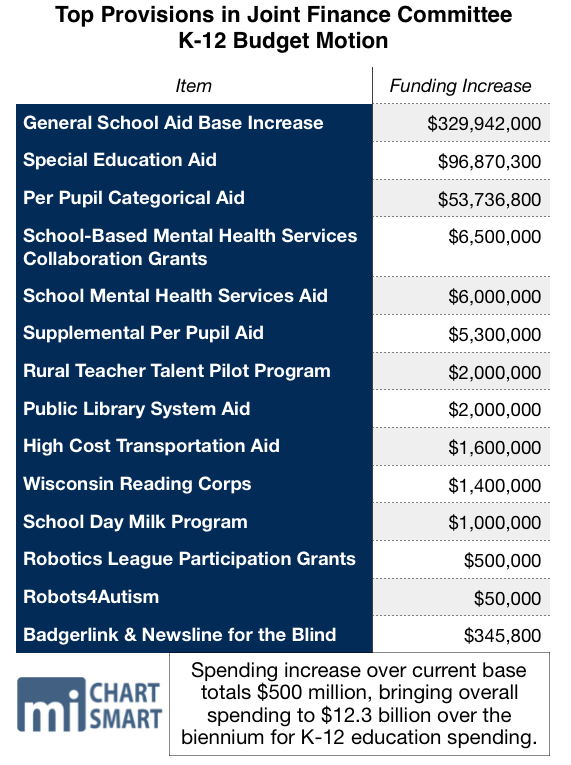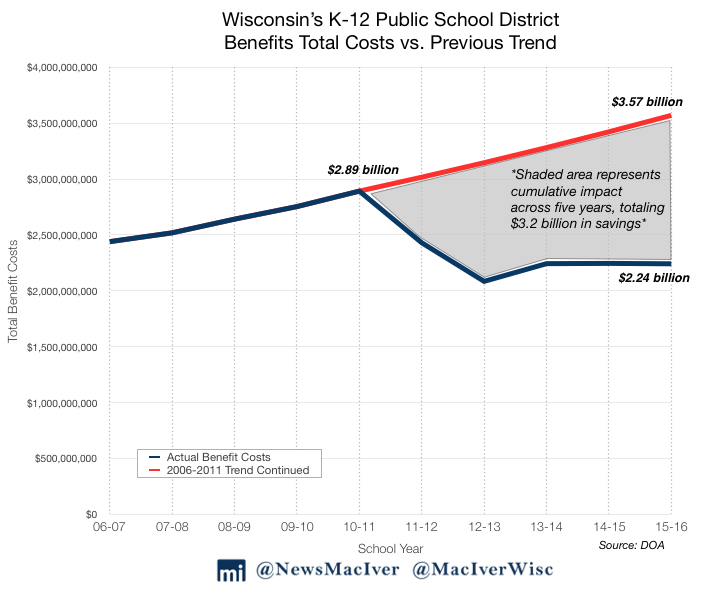Education Activists Turn To Misinformation To Distort GOP Budget
Public education activists should be honest about the large increase and they should be grateful to taxpayers for the hard-earned dollars provided to fund it
MADISON — In discussions and debates over the Joint Finance Committee’s $15.22 billion Department of Public Instruction (DPI) 2019-21 budget, some K-12 public education activists have exploited the chaos of budget season in an apparent attempt to mislead the public into thinking the JFC-passed budget actually reduces the state’s budget for K-12.
“When you’re gonna cut $900 million from our public education budget, and then allow special ed to go over a billion in the hole, that’s insane,” exclaimed State Treasurer Sarah Godlewski at a recent rally on the steps of the Capitol.
“We thought we were going to have $1.4 billion reinvested in our schools…after it went through the Joint Finance Committee, it came out $900 million short,” repeated MPS board member Megan O’Halloran at the same rally.
This rhetoric echoed that of Democrats throughout the budget process. Their claim that K-12 funding is being “cut”—which was only sometimes accompanied by the caveat that this is compared to Gov. Tony Evers’ budget proposal—is a tremendous disservice to perhaps the most important public policy debate that occurs in Wisconsin, the debate over the state budget.
The simple fact is that K-12 education is receiving a $665 million funding increase. Regardless of what Gov. Evers proposed in his budget, this sizable funding bump is the exact opposite of a cut.
Following are a series of additional facts about K-12 funding in Wisconsin offered in hopes to rein in the runaway rhetoric of a mendacious group of public K-12 advocates.
What about inflation? A group of protesters led by the Wisconsin Public Education Network spent last weekend marching to Madison, calling for more education funding and rallying against the JFC budget package. The group claims that the $665 million spending increase “doesn’t even keep pace with inflation.” However, funding to DPI will increase by 4.6 percent from the base. The rate of inflation from 2017 to 2019—the last budget period—was 4.5 percent. Their claim is false.
Doesn’t this budget slash special education funding? Godlewski claimed the JFC budget will “allow special ed to go over a billion in the hole.” Again, this is more dishonest rhetoric in an apparent attempt to sow misinformation among the public. JFC actually increases special needs aid by $97 million over the biennium, reaching the same 30 percent level of reimbursement as Evers had requested before launching his campaign for governor. Claims about cutting special education funding are craven and dishonest.
No matter how you look at it, the 2019-21 budget passed by JFC and both houses of the Legislature provides generous funding increases to K-12 public education in more than a dozen areas, particularly general school aids and special education aids.
Isn’t funding less than adjusted 2011 levels? The Wisconsin Budget Project claims that “the state provided $3.5 billion less in state aid to public schools than it would have if state aid stayed at 2011 levels.” That figure has been repeated by numerous other organizations and has appeared in material for the 60-mile march that occurred last weekend. But to use 2011 as a base year is to blatantly ignore the single most critical fact at issue—the stimulus. The state budget that year was padded with $3.5 billion in one-time federal stimulus dollars, and more than $552 million in federal money was used to backfill state aid to K-12. Ignoring this fact is misleading at best.
What about rising benefits costs? The cost of providing benefits has declined thanks to reforms under Gov. Scott Walker. To say that the landscape for public sector health insurance has changed since his collective bargaining reform law, Act 10, would be an understatement. Since the landmark bill’s passage, Wisconsin school districts have saved more than $3.2 billion in benefits costs. Those savings are cash that can be re-invested directly into the classroom or any other school district priority. The cash savings amount to a massive funding increase for school districts in its own right.
Did the Legislature-passed spending proposal meet Gov. Evers’ wildly unrealistic and unsustainable $1.2 billion increase? No, and that’s a good thing for school districts. Evers’ untenable budget increase would create the threat of actual budget cuts when there is an inevitable economic downturn in the future, much like the cuts school districts experienced in the latter years of former Gov. Jim Doyle’s tenure.
The budget about to be presented to Gov. Evers unquestionably boosts funding—by a lot. And in the event of a downturn, it’s more likely to be sustainable than Evers’ proposal.
Public education activists should be honest about the large increase and they should be grateful to taxpayers for the hard-earned dollars they provide in order to fund it.
NOTE: This press release was submitted to Urban Milwaukee and was not written by an Urban Milwaukee writer. While it is believed to be reliable, Urban Milwaukee does not guarantee its accuracy or completeness.


























